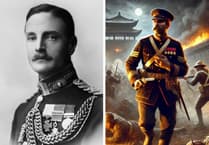In the small community of Hartley Mauditt near Alton, a strawberry farm was once the unlikely sanctuary of one of Britain’s most decorated naval heroes.
Augustus Willington Shelton Agar VC, DSO, or simply ‘Gus’ to those who knew him best, was a man whose life reads like the script of a war film: clandestine raids against the Bolsheviks, gold convoys across the Atlantic, and a desperate fight for survival in the Indian Ocean.
Born in 1890 in the Anglo-Irish tradition of service and duty, Agar’s destiny was set from the start. He entered the Royal Navy at just 14, joining an institution that would become his life.
By the outbreak of the First World War in 1914, he was a lieutenant aboard HMS Hibernia, part of Sir John Jellicoe’s Grand Fleet.
He served with distinction, yet his greatest trials - and triumphs - lay ahead.
In the murky theatre of the Baltic in 1919, where Britain sought to support the anti-Bolshevik ‘White Russian’ forces, Agar took command of one of the Royal Navy’s unglamorous but deadly Coastal Motor Boats (CMBs), fast attack vessels bristling with torpedoes.
His perilous mission was to slip past Bolshevik defences to wreak havoc in the Gulf of Finland.
On the night of June 17, 1919, with audacious skill, Agar piloted CMB 4 into Kronstadt harbour, the heart of Soviet naval power, under cover of darkness.
Despite fierce enemy fire, he sank the cruiser Oleg, a powerful symbol of Bolshevik might, before speeding back to safety.
For this daring act, Agar was awarded the Victoria Cross, Britain’s highest military honour; his citation recognising his “conspicuous gallantry, coolness and skill under extremely difficult conditions in action”.
Yet Agar’s VC tells only part of the story. He carried out other secret missions, many of which remain shrouded in mystery, and by the time the world plunged into a second global conflict in 1939, Agar was a seasoned commander.
Tasked with escorting a massive shipment of British gold reserves to Canada as part of Operation Fish, he found himself in the company of venerable warships like HMS Revenge.
The convoy braved treacherous North Atlantic storms and prowling U-boats, safeguarding the lifeblood of Britain’s war effort.
The toll of wartime service on Agar and his crews was immense. On the ill-equipped cruiser HMS Emerald, sailors endured bitter cold, surviving only with donations of warm clothing from the Canadian Red Cross. Agar was a commanding officer of rare humanity, sending his men ashore for rest while he oversaw gruelling repairs to their battered vessel.
But his most harrowing trial came in the Indian Ocean in 1942, when HMS Dorsetshire, the ship he commanded, became a target for Japanese dive bombers during the Easter Sunday raid on Colombo.
Caught in the open sea, Dorsetshire and her companion HMS Cornwall were overwhelmed by the relentless precision of the Japanese attack. Both ships were sunk, with Agar and many of his crew flung into the ocean.
Despite his own injuries - shrapnel wounds, a damaged lung from the sinking, and oil swallowed during his escape - Agar worked tirelessly to organise the survival effort.
Calm and resolute, he rallied his men, gathering the wounded and keeping morale afloat until rescue came 32 hours later.
The ordeal left Agar physically diminished, and he was deemed unfit for further sea command. Yet despite this he continued to serve, overseeing the construction of the aircraft carrier HMS Unicorn and later becoming President of the Royal Naval College at Greenwich.
In retirement, Agar found peace tending strawberries at his farm in Hartley Mauditt.
His beloved CMB 4, the vessel that had carried him to glory, made a final farewell visit to Alton in 1967 before being enshrined at the Imperial War Museum’s Duxford site in Cambridgeshire.
Agar passed away at home in Anstey Park House on December 30, 1968, aged 78, and his body was laid to rest in Alton Cemetery.
.png?width=752&height=500&crop=752:500)


.png?width=209&height=140&crop=209:145,smart&quality=75)
